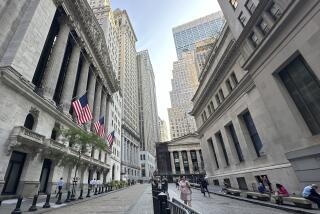NEWS ANALYSIS : The Buck Hops Here : Currency: Its sharp rally reflects a fundamental shift in traders’ view of the dollar and the world economy.
- Share via
The sharp rally in the dollar--aided most recently by a dramatic joint effort by U.S., German and Japanese central banks to boost the U.S. currency--reflects a fundamental shift in currency traders’ view of the beleaguered greenback and the world economy.
After pushing the dollar to postwar lows this spring, traders in the past month have aggressively bought dollars out of a belief that the Japanese and Western European economies are so sluggish that a weaker Japanese yen and German mark are necessary to help them recover.
Those economies have deteriorated in large part because their rich currencies have made their manufactured goods too pricey for the vast American market and thus have crimped their exports.
“The dollar got undervalued . . . to the point where Japanese and German companies simply could not compete at those exchange rates,” said Joshua N. Feinman, global markets economist at Bankers Trust New York Corp.
Thus, the central banks’ action Tuesday--in which they massively bought dollars to drive the greenback to six-month highs--took advantage of those market conditions. And some analysts predicted the triumvirate will continue trying to exploit the dollar’s favorable wave in coming weeks.
How much? Currency traders and government officials indicated that the three nations have no specific target for the dollar but that the goal is to lift it against the yen and the markto where the Japanese and German economies begin to show noticeable improvement.
That would require a dollar equal to at least 100 yen and 1.5 marks, analysts said, meaning the greenback would have to appreciate at least another 2% to 3% against those currencies. But some economists had already predicted that the dollar would reach those levels by year’s end.
“It’s clear the dollar would be going higher even if the central banks weren’t intervening,” said Dan Bernstein, research director at the investment firm Bridgewater Group in Wilton, Conn.
However, other money managers noted that the dollar is rallying in light summer trading, and they worry that the currency could reverse course in heavier trading--even with more central bank intervention.
When “the bigger players come back to work in September, we could see the dollar lose some ground,” said Donald P. Gould, president of the Franklin Templeton Global Trust mutual fund group.
For several months, the Federal Reserve Board, the Bank of Japan and the German Bundesbank--with the help of other central banks at times--have followed a coordinated policy of trying to stem the prolonged battering of the dollar.
Those intervention efforts, in which the banks would periodically move into the open market unannounced and buy billions of dollars, seldom worked. The desire among foreign exchange traders to keep lifting the yen and mark at the dollar’s expense had typically overwhelmed the central banks’ attempts to reverse the tide.
Nonetheless, in April the so-called Group of Seven leading economic powers reiterated its determination to boost the dollar, saying the greenback was too low given conditions in the global economy.
Traders eventually embraced that view and also figured that the United States would gladly join the dollar’s defense because it “did not want to get into a situation where its currency was spiraling down and being debased forever,” even though the stronger dollar could hurt the profits of U.S. multinational corporations, economist Feinman said.
Seeing such a favorable climate for the dollar, the three central banks seized the opportunity Tuesday and once again jointly intervened--this time with dramatic success--as the dollar rose 3% against the yen and mark in that session alone.
“The central banks have gotten on the side of everybody else, as opposed to the spring, when everybody was pushing the dollar down and the central banks were trying to fight that,” Feinman said.
While refusing to make any formal comment Wednesday, Clinton Administration officials said privately that there had been a need for an orderly reversal in the dollar’s slide.
It “was a very brilliant tactical move to intervene when they did,” said Charles Holdstock, vice president for foreign exchange at State Street Bank & Trust Co. in Boston. “Given the fact that the market is normally fairly quiet in August, it was a very propitious time for the central banks to intervene.”
Peltz reported from Los Angeles and Rosenblatt from Washington. Times staff writer Kathy M. Kristof also contributed to this report.
(BEGIN TEXT OF INFOBOX / INFOGRAPHIC)
The Dollar’s New Strength
The dollar has made strong gains against the yen and mark in recent weeks, gaining sharply Tuesday due to a combined intervention of the central banks of the United States, Japan and Germany. The push is an effort to weaken the yen and mark and thus help the lagging economies of Japan and Western Europe.
THE DOLLAR IN YEN. Wednesday: 97.78
THE DOLLAR IN MARKS. Wednesday: 1.478
*
IN JAPAN...
Gross domestic product. Yearly percentage change: 1996, estimates 1.5%
Consumer confidence. Quarterly index: 1995, 73
Unemployment. July, 1994 to July, 1995, monthly percentage: 3.2%
IN GERMANY...
Gross domestic product. Yearly percentage change: 1996, estimates 2.2%
Consumer confidence. Quarterly index: 1995, 90.7
Unemployment. July, 1994 to July, 1995, monthly percentage: 9.2%
Sources: Trade Line, Goldman Sachs, Datastream.
Researched by JENNIFER OLDHAM / Los Angeles Times
More to Read
Sign up for Essential California
The most important California stories and recommendations in your inbox every morning.
You may occasionally receive promotional content from the Los Angeles Times.














